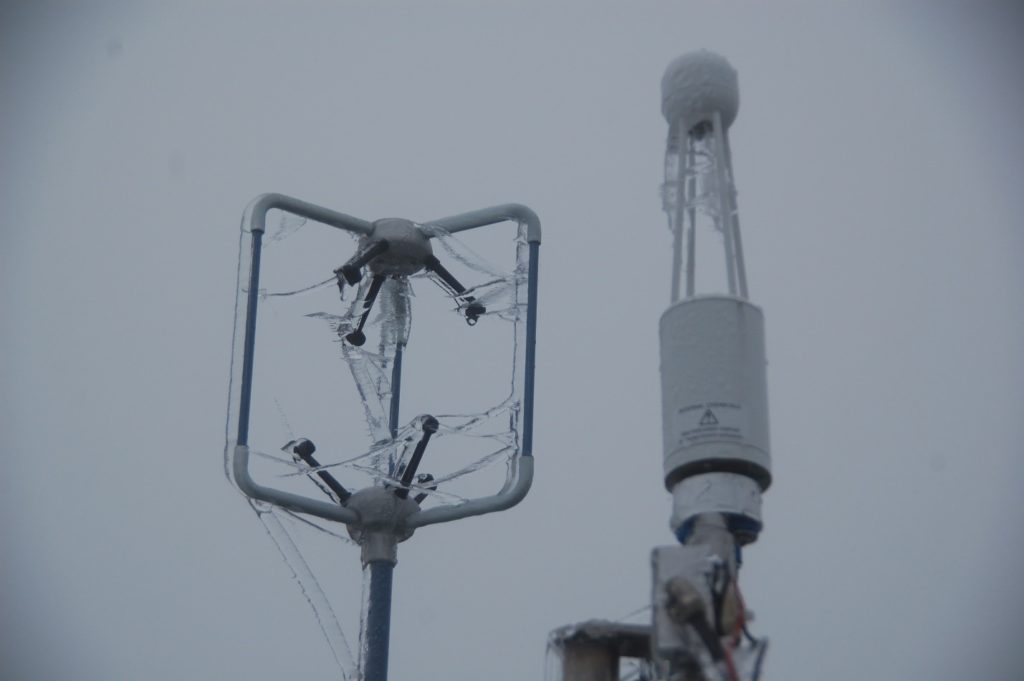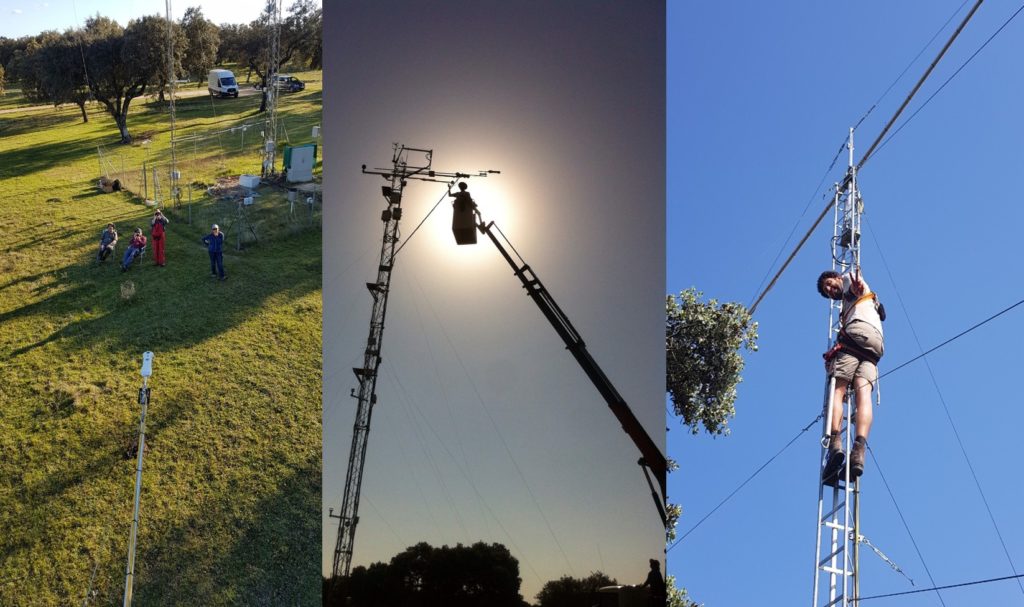This month, we are pleased to interview Tarek S. El-Madany. Tarek S. El-Madany is a postdoc at the Department of Biogeochemical Integration, Max Planck Institute for Biogeochemistry. His research interest is in biosphere-atmosphere interactions (greenhouse gases and fog) and the identification of relevant processes as well as their driving factors. Further interests are water and carbon dynamics from small scales to landscape scales. He has worked with eddy covariance since he was an undergrad. Currently, he is working on the MaNiP project with a focus on nutrient-availability and plant trait interactions. We interviewed him to learn his research using eddy covariance and his career path.
Please tell us briefly about yourself

On top of the tower at ES-Abr for calibrating and exchanging the filter of the infra-red gas analyzer
When I started to study biology, I found out quickly that I’m not the guy for a scientific career in the lab. So, I changed the subject and started to study landscape ecology, which was the best decision of my life. Besides meeting my wife, I had my first contact with eddy covariance (EC), which has coined my science ever since. Besides doing airborne EC measurements for my diploma thesis, I had the opportunity to spend much time during my Ph.D. work in Taiwan at Chi-Lan Mountain a cloud forest ecosystem where I conducted EC-based fog droplet flux measurements and studied the impact of nocturnal flow patterns on CO2 and energy fluxes.
For my post-doc, I moved with my family to Jena (Germany) to the Max Planck Institute for Biogeochemistry where I have worked since 2014 in the Biosphere-Atmosphere Interactions and Experiments group with Mirco Migliavacca. Here, I’m responsible for a large-scale nutrient manipulation experiment (MaNiP) in western Spain, where we fertilized two footprint areas of about 20 ha with Nitrogen (N) and N + Phosphorus (P), respectively.

Ice-covered EC system from supercooled fog droplets that impacted on the spiderwebs and the structure of the sonic anemometer as well as on the infra-red gas analyzer.
What are your most recent studies?
I’m currently working on the impacts of different environmental drivers on semi-arid ecosystems. My current work focused on the timing of droughts in two very similar semi-arid ecosystems along a precipitation gradient (paper). It showed nicely that droughts are most severe in spring and autumn while summer droughts have nearly no impact on the annual carbon balance. Further, I’m focusing on the impacts of nutrient availability and stoichiometric imbalance on water-use efficiency (WUE) at the ecosystem scale. The ongoing deposition of N to ecosystems, while P inputs are missing, potentially results in an imbalance of available N and P. This N-induced P-limitation might affect ecosystem functioning. Within the MaNiP experiment, I was able to show that the stoichiometric imbalance in the N: P-ratio resulted in a 10% increase of evapotranspiration at the annual scale compared to the control treatment. Further, both fertilized treatments increased the carbon uptake but the N+P treatment even reduced evapotranspiration. As a result, WUE was lower in the N-only treatment as compared to the N+P treatment.
What skills do you feel you need to acquire to make your studies more effective? What advice would you give to other new beginners?
When working with large data sets it is always useful to work on your programming skills and to ensure the reproducibility of code and data processing. Further, it is important to do some basic checks on consistencies across the data sets. I guess one of the most common issues is associated with the unit of pressure or the vapor pressure deficit (usually hPa or kPa) which can cause quite some problems down the processing line. 😉
Fun stories working in the field.
The biggest challenge in the field happened to me in Taiwan shortly before Christmas. Temperatures dropped below zero °C and a long-lasting fog event occurred. The supercooled fog droplets froze on every instrument on the tower and created ice crusts. The ice crust had to be removed from some instruments to prevent damage. Unfortunately, I was not prepared for these weather conditions and had only very thin working gloves. After about two minutes on the tower, my gloves were already completely wet and the water temperature was about zero °C. After the task was finished and I was back on the ground, I was really worried about my fingers, but they recovered at the fireplace with a nice bowl of hot noodle soup.
One of the best experiences in the field was after a full night of manual chamber measurements during summer in Spain together with Arnaud Carrara. We started in the evening with the measurements and finished around 10 the next morning. It was a warm and beautiful clear sky night we even saw some shooting stars. After we downloaded the data, started the charging of the batteries, and cleaned everything up we decided to go for lunch. We really needed a break and a bed. The place we went to was next to a river. After lunch, we went to the river, sat on some big rocks, and enjoyed our well-deserved nap with our feet in the water. A perfect ending of a great measurement campaign.

Left: While I’m on top of a radiometric tower and trying to level a reference panel for a calibration. Four of our co-workers are enjoying the view and give great comments like “a little bit more to right…. A little higher…. That was too much”. Middle: I’m in a crane cleaning the radiation sensors at ES-LMa. Right: Safety first! A good climbing gear is worth a million in case the tasks on the tower take longer than expected.
Who have been your mentors and how have they helped you arrive at where you are today?
My Ph.D. advisor Otto Klemm taught me the depth and beauty of eddy covariance measurements, plus a solid base for scientific working. When coming to Jena in 2014 I learned from Mirco Migliavacca how to combine field measurements across scales and to link them to ecosystem functioning. Without the support of Mirco within the last six years, I would not be here today.
Additionally, I met many amazing people during my scientific career who enriched my perspectives on science, politics, and friendships. Bruno Neininger showed me during many flight hours in his Dimona a completely new perspective of atmospheric turbulence and trace gas transport. In Taiwan, Shih-Chieh Chang taught me about the relevant ecosystem processes in mountain cloud forests and the Taiwanese cuisine and culture. Arnaud Carrara and I spend so much time together in the field and discussed so many scientific and non-scientific aspects of life that he definitely shaped my science. Last but not least I have to name the community of scientists within the MPI-BGC from the directors to the PhD-students who have a great culture of scientific discussion. These ongoing discussions with different perspectives broadened my scientific research.
What resources do you think the flux networks have provided or could potentially provide to help your studies and career?
The FLUXNET mailing list is most likely the best place to find job offers in our field of research. It actually got me my current job. With respect to my research, the different communities offer a great platform to get in contact with other researchers who are working on similar topics or ecosystems. The willingness to share data and code is impressive. I recommend a look into the Toolbox (https://fluxnet.org/2017/10/10/toolbox-a-rolling-list-of-softwarepackages-for-flux-related-data-processing/) organized by Ladislav and Housen, there are many useful tools out there developed by the community for the community. Use and cite them!
Things you wish you knew when you started your postdoc.
Science is a lot about the things that we don’t know, so I would say the less you know the better.
